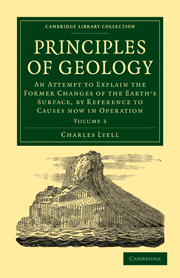 Principles of Geology
Principles of Geology Book contents
- Frontmatter
- PREFACE
- Contents
- LIST OF PLATES AND WOOD-CUTS IN THE THIRD VOLUME
- LIST OF WOOD-CUTS
- ERRATA
- CHAPTER I
- CHAPTER II
- CHAPTER III
- CHAPTER IV
- CHAPTER V
- CHAPTER VI
- CHAPTER VII
- CHAPTER VIII
- CHAPTER IX
- CHAPTER X
- CHAPTER XI
- CHAPTER XII
- CHAPTER XIII
- CHAPTER XIV
- CHAPTER XV
- CHAPTER XVI
- CHAPTER XVII
- CHAPTER XVIII
- CHAPTER XIX
- CHAPTER XX
- CHAPTER XXI
- CHAPTER XXII
- CHAPTER XXIII
- CHAPTER XXIV
- CHAPTER XXV
- CHAPTER XXVI
- Table I Showing the relations of the various classes of rocks, the Alluvial, the Aqueous, the Volcanic, and the Hypogene, of different periods
- Table II Showing the order of superposition of the principal European groups of sedimentary strata mentioned in this work
- Notes in explanation of the Tables of fossil shells in Appendix I
- Appendix I Tables of fossil shells by Monsieur G. P. Deshayes
- Appendix II Lists of fossil Shells chiefly collected by the author in Sicily and Italy, named by M. Deshayes
- Glossary, containing an explanation of geological and other scientific terms used in this work
- Index
- WORKS ON SCIENCE AND NATURAL HISTORY
- Plate section
- Frontmatter
- PREFACE
- Contents
- LIST OF PLATES AND WOOD-CUTS IN THE THIRD VOLUME
- LIST OF WOOD-CUTS
- ERRATA
- CHAPTER I
- CHAPTER II
- CHAPTER III
- CHAPTER IV
- CHAPTER V
- CHAPTER VI
- CHAPTER VII
- CHAPTER VIII
- CHAPTER IX
- CHAPTER X
- CHAPTER XI
- CHAPTER XII
- CHAPTER XIII
- CHAPTER XIV
- CHAPTER XV
- CHAPTER XVI
- CHAPTER XVII
- CHAPTER XVIII
- CHAPTER XIX
- CHAPTER XX
- CHAPTER XXI
- CHAPTER XXII
- CHAPTER XXIII
- CHAPTER XXIV
- CHAPTER XXV
- CHAPTER XXVI
- Table I Showing the relations of the various classes of rocks, the Alluvial, the Aqueous, the Volcanic, and the Hypogene, of different periods
- Table II Showing the order of superposition of the principal European groups of sedimentary strata mentioned in this work
- Notes in explanation of the Tables of fossil shells in Appendix I
- Appendix I Tables of fossil shells by Monsieur G. P. Deshayes
- Appendix II Lists of fossil Shells chiefly collected by the author in Sicily and Italy, named by M. Deshayes
- Glossary, containing an explanation of geological and other scientific terms used in this work
- Index
- WORKS ON SCIENCE AND NATURAL HISTORY
- Plate section
Summary
EOCENE FORMATIONS–PARIS BASIN.
The geologist who has studied the lacustrine formations described in the last chapter cannot enter the tract usually termed ‘the Paris Basin’ without immediately recognizing a great variety of rocks with which his eye has already become familiar. The green and white marls of Auvergne, Cantal, and Velay, again present themselves, together with limestones and quartzose grits, siliceous and gypseous marls, nodules and layers of flint, and saccharoid gypsum ; lastly, in addition to all this identity of mineral character, we find an assemblage of the same species of fossil animals and plants.
When we consider the geographical proximity of the two districts, we are the more prepared to ascribe this correspondence in the mineral composition of these groups to a combination of similar circumstances in the same era. From the map (No. 56, p. 226) in the last chapter, it will be seen that the united waters of the Allier and Loire, after descending from the valleys occupied by the fresh-water formations of Central France, flow on till they reach the southern extremity of what is called the Paris basin. M. Omalius d'Halloy long ago suggested the very natural idea that there existed formerly a chain of lakes, reaching from the highest part of the central mountain-group of France, and terminating in the basin of Paris, which he supposes was at that time an arm of the sea.
- Type
- Chapter
- Information
- Principles of GeologyAn Attempt to Explain the Former Changes of the Earth's Surface, by Reference to Causes now in Operation, pp. 241 - 256Publisher: Cambridge University PressPrint publication year: 2009First published in: 1833


